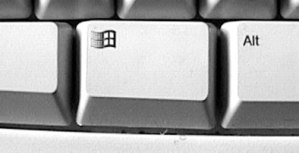Shortcuts, and the “Windows” key
I do pretty well, but I am not a fast typist. This is due to the fact that I just never seemed to get the hang of touch typing, or never made the proper effort in mastering it. I use a bizarre method of two-handed hunting/pecking and common key memorization that astounds observers. The reason I am as fast as I am is my use of keyboard shortcuts to navigate, edit, and control the machine. (A brief aside: I have tried voice recognition, but just cannot get used to talking to my computer; it makes me feel foolish.)
In the Realm of the Geek, one measure of your skill is how much you can do without touching your mouse. You may not know this but there is almost nothing you cannot do using only the keys on your keyboard. Using keyboard shortcuts is much faster, and gives me more granular control over my selections.
Tip(s) of the day: Use some common shortcuts to maximize your efficiency.
I will start by pointing out what a quite a few of us simply were never told (unless we’ve been using Windows for many generations). You may have noticed (in some programs) that there’s a single letter underlined in each menu choice (and that this is standardized across all programs), such as the F in the File menu, E in Edit, and the o in Format, and this carries to submenus as well. These are “Alt shortcuts”– hold down the “Alt” key and hit F, and the File drop-down menu opens; hit the down arrow one time, and the Open dialogue opens; use the up and down arrow keys to select your file and hit Enter, and your file opens. All without touching the mouse.
One more important Alt shortcut is Alt+Tab: this cycles through your open program windows.
You may have also noticed a weird key located on the lowest left, between the “Ctrl” and “Alt” keys, that has the Windows logo on it.  Believe it or not this “Windows” key actually serves a purpose and does things. A single tap opens your Start menu (again, the up/down arrows will allow you to select [highlight] your choice of the options). Combine it with other keys to: R, opens the Run tool; M, minimizes all open windows (sometimes handy for when the boss walks by); and E opens Windows Explorer.
Believe it or not this “Windows” key actually serves a purpose and does things. A single tap opens your Start menu (again, the up/down arrows will allow you to select [highlight] your choice of the options). Combine it with other keys to: R, opens the Run tool; M, minimizes all open windows (sometimes handy for when the boss walks by); and E opens Windows Explorer.
For navigating, the tools to use are the arrow keys. To move around in a document, a single click on an arrow key moves it one character; this is not a fun way to move whole sentences or paragraphs, so add the Ctrl key to move by whole words (or other blocks of characters) on the left/right keys and paragraphs with the up/down keys. To highlight (select) the text, add the Shift key. Say I wanted to delete this whole paragraph, I would hit Ctrl+Shift+up arrow, and then either Delete or Backspace.
The Page Up and Page Down keys can speed your scrolling.
“Command shortcuts” are typically done with the Ctrl key, and you probably already are familiar with some of them: Ctrl+C is the Copy command, Ctrl+V is Paste, and — my favorite — Ctrl+Z is the Undo command. Others are: Ctrl+P followed by Enter will print your current page/document, Ctrl+S will Save it.
These are “universal” commands and can be used no matter which program or application you happen to have open. Most programs have their own set of shortcuts built in as added features, and if you use them a lot learning these can be a real boon. As a for instance, Microsoft Word has a whole slew of shortcuts, and the ability to record “macros”, to reduce the number of steps you need to accomplish tasks. If you’re an Administrative Assistant (or otherwise spend a lot of time in Word), I suggest a search for “Word shortcuts” will be a big benefit to you as there’s a lot of published guides out there. I have only presented a very short list of the shortcuts available!
Today’s free link: While not everyone is a Word user, most people are web browsers (how else did you find Tech–for Everyone?). The official Microsoft list of Internet Explorer shortcuts can be found here.
Copyright 2007 © Tech Paul, All Rights Reserved
| Share this post : |

 Subscribe to Tech--for Everyone by Email
Subscribe to Tech--for Everyone by Email












Nice website! Not too much new info for me, I’m using keyboard shortcuts as much as I know them.
But yesterday I found an amazing feature and I’m thinking about its possibilities.
Yesterday – when working on a Word-document – I mistyped as shortcut key (used WinKey+S in stead of CTRL+S to Save a document). Amazing: a voice started to read the document I was writing!!
I googled a little to find out what the formal description of the Word-function is that I triggered by the WinKey+S, but up to now could not find it.
is there official MS-documentation about this feature as far as you know?
regards,
Hans
LikeLike
Hans–
I believe that you triggered the Accessibility feature called “Microsoft Narrator”, which recognizes on-screen text and vocalizes it. This is to help people with vision difficulties.
Text recognition/Narrator is a part of the operating system and is not specific to Word, and there are many documents regarding Narrator on the Microsoft website.. from using it, to customizing it, to troubleshooting it.. and not just a single factsheet. However, you might start by looking here, http://www.microsoft.com/enable/training/windowsvista/narrator.aspx
LikeLike